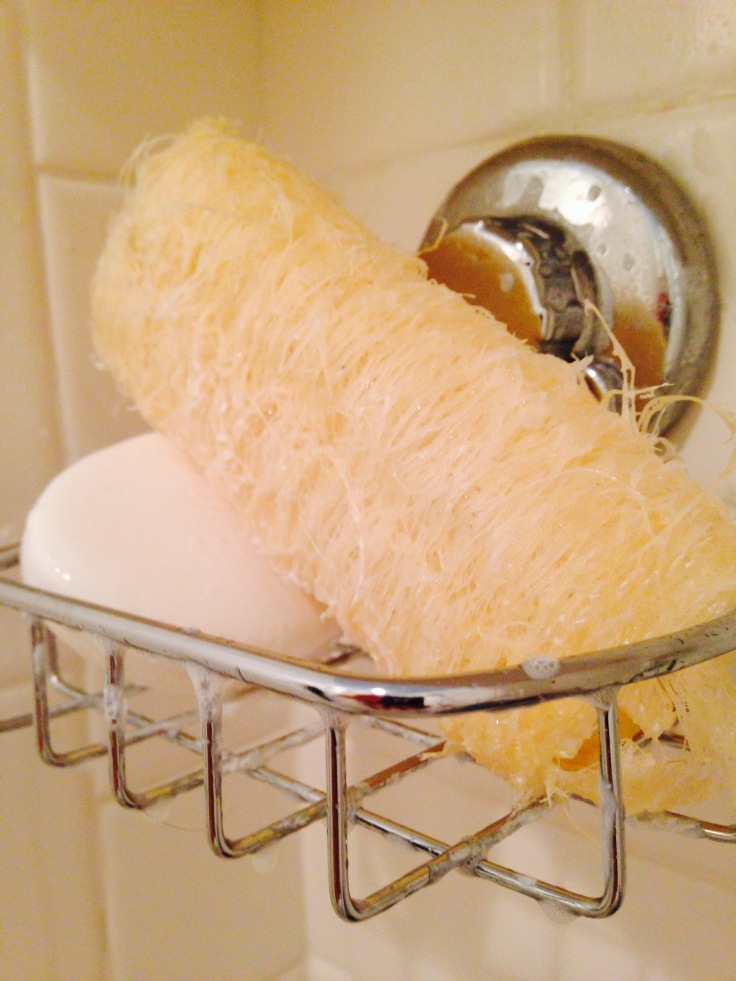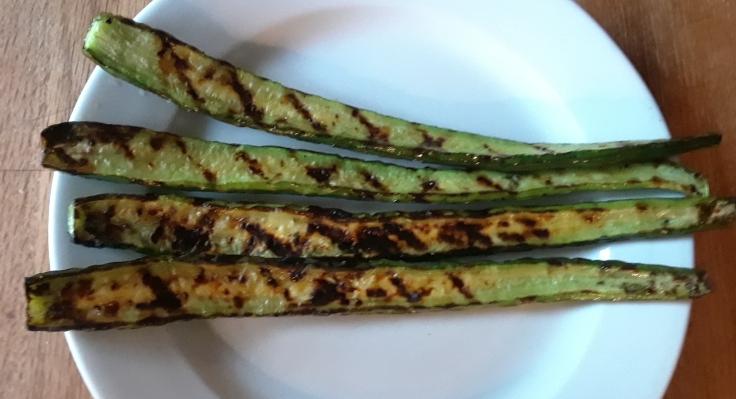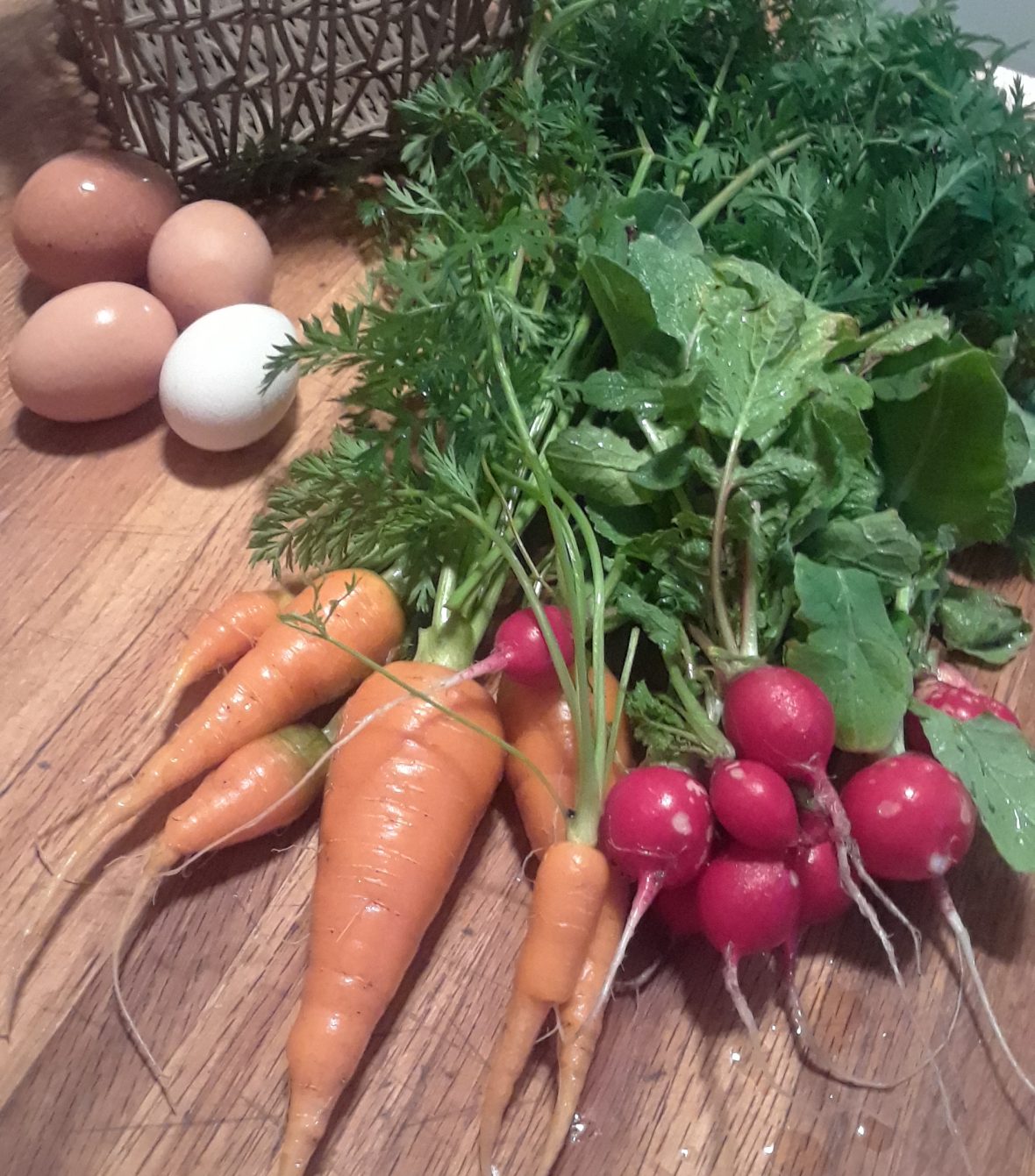I really do love loofah, specifically Ridged Luffa, Luffa Acutangula. It is also known as ridged gourd, loofah (the spelling used for the sponge), Chinese okra, silk melon, dishcloth gourd, angled luffa, vegetable gourd, and many other aliases. Whatever you call it, luffa is a truly versatile plant with as many uses as names, and it is–without a doubt–one of the most rewarding things I’ve ever grown.
We grow our glorious luffa vines on a stretch of wooden rail fence that runs down one side of our front yard, where it gets plenty of attention from passersby. We have had several people stop on the side of the road to ask us, “What are your beautiful vines with those funny looking clubs?”. The vines are massive with only two of them covering over 50 feet of fencing.
 They are definitely not a crop for square foot gardening or tiny spaces. But, if you have room for a luffa vine, you should try growing this fun, versatile, and beautiful plant.
They are definitely not a crop for square foot gardening or tiny spaces. But, if you have room for a luffa vine, you should try growing this fun, versatile, and beautiful plant.
Loofah is well known by many people as the scrubbing sponges sold in bath and beauty shops.
 Some people are actually quite surprised to learn that the sponges are, in fact, the fibers from mature gourds. Those fibers do make great bath sponges for exfoliating, and they are also useful to have in the kitchen for scrubbing pots and pans. The sponges are nice to have around, but luffa is so much more than a sponge. It can be used as fire starter, insulation, and even as a component of fiberboard panels. There are many more uses of this incredible plant, but this is DiggingFood.com not Digging AmazingPlantsThatCanDo Everything.com. So, I will tell you why and how to grow Ridged Luffa for food.
Some people are actually quite surprised to learn that the sponges are, in fact, the fibers from mature gourds. Those fibers do make great bath sponges for exfoliating, and they are also useful to have in the kitchen for scrubbing pots and pans. The sponges are nice to have around, but luffa is so much more than a sponge. It can be used as fire starter, insulation, and even as a component of fiberboard panels. There are many more uses of this incredible plant, but this is DiggingFood.com not Digging AmazingPlantsThatCanDo Everything.com. So, I will tell you why and how to grow Ridged Luffa for food.
There are three species of Luffa, all of which produce sponges and are edible when young. My dearly loved Angular/Ridged Luffa is the only one that is more than just “edible,” it’s incredibly delicious. This gourd is a vegetable beloved in several Asian cultures. It is used in many dishes in China where it is usually referred to as silk melon. But some people also refer to it as Chinese Okra. In India, Luffa is cooked in stews and curries, and it is the primary ingredient in many dishes. When it is used in Indian cuisine, it is referred to as Ridged Gourd or Taroi.
Chinese, Vietnamese, and Indian cultures embrace Luffa and it’s health benefits. It is said to have a “cooling” effect and to aid in digestion and weight loss. I’m not sure about the legitimacy of those claims, but they sound great to me. Some of the Luffa dishes we enjoy are incredibly healthy. However, I l doubt Luffa will actually help with weight loss in our home because many of the ways I prepare Luffa include cheese or frying.
There are countless delicious ways to enjoy Luffa. The maturity and size of the gourd determine which way is best. 
The very young and tender gourds can be thinly sliced, with skins intact, to be used raw in salads. They are better than cucumbers, but can serve similarly. The young gourds can also be sliced, battered, and fried like okra.
As the gourds get a bit larger, but are still tender, they can be cooked in just about any way that you would prepare a Zuchinni. They are great grilled, stir fried, or baked in cheesy casseroles. Believe me, loofah is a great squash substitute. But, it is actually more than just a substitute because I would prefer Luffa. It is a bit sweeter than squash and less watery. I think it actually makes a far better and more interesting casserole than squash.
The uses of Luffa change as the vegetables mature because their skin gets thicker and eventually inedible. When smaller than 3″ inches in diameter, they usually don’t need to be pealed. When the gourds are 3″ or more in diameter, most are peeled before being used in Asian soups and stews. Once the gourds reach around 24″ in length, they start to become fibrous and are best left to mature for use as sponges.
The full life cycle of the Luffa vine is a long one. To have mature gourds for use as sponges, you need 120-140 warm Summer days, making this a perfect crop for long Southern Summers. But, this shouldn’t keep Northern gardeners from enjoying this vine. I would grow this fabulous plant even if it were for only one of the uses I’ve mentioned. If I could only have tiny Luffa gourds for salad toppers or frying, I would still plant them.
If the vines were started indoors and transplanted in Spring, edible Luffa could probably be grown in some gardens as far north as zones 5 and 6. Anyone, with a large fence or trellis and 90-100 days of Summer, should try to grow this plant.
If squash borers destroy your squash every year, grow Luffa.
If you love cooking Asian food, grow Luffa.
If you like grilling vegetables, grow Luffa.
If you like pretty yellow flowers, grow Luffa.
If you want to have the most impressive giant vine in your neighborhood, grow Luffa.
If you have a naked fence that needs to be covered in beauty, grow Luffa.
When you decide, as you surely will, to grow Ridged Luffa, you will just need a few seeds. Well, unless, I’ve inadvertently convinced you to start a Luffa farm. Once you purchase a few seeds , you will never have to purchase them again. One mature Luffa gourd will produce enough seeds for you to start a farm or share with plenty of your friends. Since I will once again have more seeds this fall than I will possibly need, I might as well share. I will be happy to send some your way. The first 10 diggingfood followers to email me their addresses will get free Luffa seeds. Send those addresses to diggingfood@gmail.com and be sure to put “Luffa Seeds” in the subject field on those emails. I only ask that you entertain me by sharing pictures of your beautiful Luffa vines next Summer. You can share those pics with Digging Food on Facebook or Instagram. I want to see the world covered in Luffa acutangula! All you need are those seeds and the following growing tips.
Growing Luffa
- The seeds are very hard and can be slow to germinate. To speed germination, lightly trim one side of each seed by clipping with nail clippers.
- Plant on hills amended with plenty of good quality compost.
- Plant 2-3 seeds together and choose the strongest plant when the seedlings develop their first true leaves.
- One plant is all you need because they are self pollinating. I grow 2 plants each year spaced 2 feet apart and train them to grow in opposite directions. These plants get huge and need plenty of room.
- Plants need strong supports. These vines need to climb and their gourds need to be kept off the ground while maturing. If planted on cattle panels or tall trellises, they will reach for the sky and create impressive vertical gardens.
- The vines will start off slow in Spring; and, then, they will grow rapidly in Summer heat.
- Fertilize with high nitrogen granular fertilizer when vines are 2-3 feet long. Lightly work the fertilizer in the top inch of soil.
- After fertilizing the young plants, mulch with a generous layer of natural mulch.
- Young luffa vines need plenty of water. But, once established they are fairly drought tolerant. The more you water them, the bigger the vines will be and the larger the gourds will grow.
- The plants will be covered with male flowers for several weeks before they start producing female flowers. So, don’t worry if you do not see fruitful flowers at first. The female flowers are obviously different because they have very tiny gourds at the base of the flowers. They are so lovely!

- Luffa blooms open in the evening and attract an interesting array of pollinators. They are sometimes pollinated by small nocturnal moths that are beautiful in themselves. They can also be pollinated by many varieties of bees and wasps. So, visit your Luffa vines in the evenings, pull up a chair and be entertained by your garden friends doing their duties.

- Once pollinated, The gourds grow incredibly fast. Plan on picking them every couple of days if you are going to eat them.
- Loofah grown to full maturity is not ready to be harvested until it starts to yellow or turn brown. This will probably not happen until very late in the Fall. The skin of mature loofah that is ready to be peeled, should feel like the outside of a football.
- Peeling luffa to unveil it’s beautiful inner sponge is really not very much fun. If I were growing the plant for the sole purpose of producing sponges, I would grow smooth luffa–a much easier variety to peel. However, the sponges produced by ridged luffa are quite nice and worth the effort. I tried several methods of peeling and found that the easiest way is to cut a slit down the side of the loofah and use a box cutter to assist in the removal of the leathery skin: a process similar to removing the hide from an animal (I’m sorry vegan friends. That is the best description I can give). I would be ecstatic if any of my readers could share an easier peeling method with me.

- One Luffa vine will yield plenty of food, and one mature Luffa gourd will yield plenty of decent sized sponges. So, plan on big vines and big production!


Wow. Incredibly informative. Thanks.
LikeLike
I guess mine are smooth, and we’ve counted 7 or 8 so far on the vine that wandered to the garden/back pasture fence. I’ve also got one ridged from seeds you gave us! Excited to see what it will do!
LikeLike
Great info and love the photos too.
LikeLike
Thank you. Glad you enjoyed it.
LikeLiked by 1 person
How long before the female flowers appear?
my first vine has 3 gourds but that’s all. I don’t see any female flowers on my other vines are the are about 5 feet tall.
LikeLike
3 or 4 weeks
LikeLike
Taking off the end and submerging in water until the skin gets leathery, then peeling helps. But then you can’t shake seeds out easily, so leave to dry again before doing so.
LikeLiked by 1 person